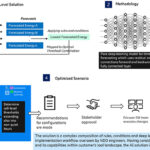Dynamic voltage and frequency scaling (DVFS) is a common energy-saving technique used in computer processor ICs based on the quadratic relationship between power consumption and operating voltage and the linear relationship between power consumption and frequency. It reacts to changing operating demands on the processor to minimize energy consumption.
The addition of artificial intelligence (AI) and machine learning (ML) can enable faster implementation of DVFS by anticipating changes before they occur, speeding the initialization of DVFS, and enabling even greater energy savings through ‘anticipatory power management.’ This FAQ reviews three approaches to integrating AI with DVFS.
Integrating AI and DVFS requires a deep understanding of processor power consumption factors and processor usage patterns. That understanding should begin at the design stage. For example, an automated power modeling framework for runtime power introspection in high-volume commercial microprocessors, called APOLLO, has been developed. APOLLO employs AI to identify 100 key signals in the processor during system development. The signals are selected based on their correlation with power consumption and are used to build a power consumption model.
APOLLO has proved to be highly accurate. When used to model the power consumption of an Arm Neoverse N1 and an Arm Cortex-A77, APOLLO’s power estimations had an R-squared of > 0.95 and > 0.94, respectively. (R-squared represents the proportion of the variance for a dependent variable, like power consumption, that’s explained by independent variables like the 100 key signals.)
Next, the power model is integrated into the microprocessor implementation as a runtime on-chip power meter (OPM) that provides fine-grained temporal resolution in a low-overhead design. The OPM delivers per cycle resolution and < 1% area/power overhead while delivering high accuracy (Figure 1).

AI DVFS for Intel Meteor Lake processor
Intel has added AI with DVFS to its Meteor Lake processors. Using AI, the processor ‘understands’ user activities and can anticipate how the demands on the processor will change in the immediate future, for example as a user opens and scans a webpage. The AI algorithm is ‘self-teaching’ and extracts use patterns that are more detailed and accurate than can be implemented through preprogramming.
With this implementation of anticipatory power management, Intel can make Meteor Lake processors that are both more responsive and use less energy. By anticipating user actions, responsiveness in moving into a higher power state is improved by up to 35% while improving overall energy savings by up to 15% by anticipating when to move into a lower power state (Figure 2).

Observer-controller loop ML for power management
Another research effort developed smart dynamic power management (SmartDPM) based on ML. SmartDPM continuously analyses workload activities and power consumption based on an observer-controller model to develop updated predictions of the power management strategy in real time. The weights in the predictor function are continuously updated to minimize deviations and errors. The implementation of SmartDPM can be described in two stages (Figure 3):
- First – the workload versus energy consumption model is built based on actual operating parameters. This is the observer stage. SmartDPM uses a lightweight linear predictor with continuous feedback of prediction errors to implement ML and improve the model. The model building also considers sporadic variations in usage that don’t fit the standard model. Sporadic variations are captured during the optimization phase.
- Second – the model is used to determine the optimal values for voltage and frequency to minimize energy consumption while maintaining the needed computing performance. This is the controller stage. The initial implementation of SmartDPM included four VF pairs. Using anticipatory power management to control the use of those four levels produced a 15% power savings compared to standard DVFS implementation.

Summary
AI and ML are being used to implement anticipatory power management and improve the performance of DVFS in processor systems. There are several ways to implement anticipatory power management, and in two cases, energy savings of 15% were realized.
References
AI Models Microprocessor Performance in Real-Time, Duke University
APOLLO: An Automated Power Modeling Framework for Runtime Power Introspection in High-Volume Commercial Microprocessors, Association of Computing Machinery
Intel will use AI to power-efficiency manage next-gen Meteor Lake CPUs, Lansheng Technology
SmartDPM: Machine Learning-Based Dynamic Power Management for Multi-Core Microprocessors, American Scientific Publishers







Leave a Reply